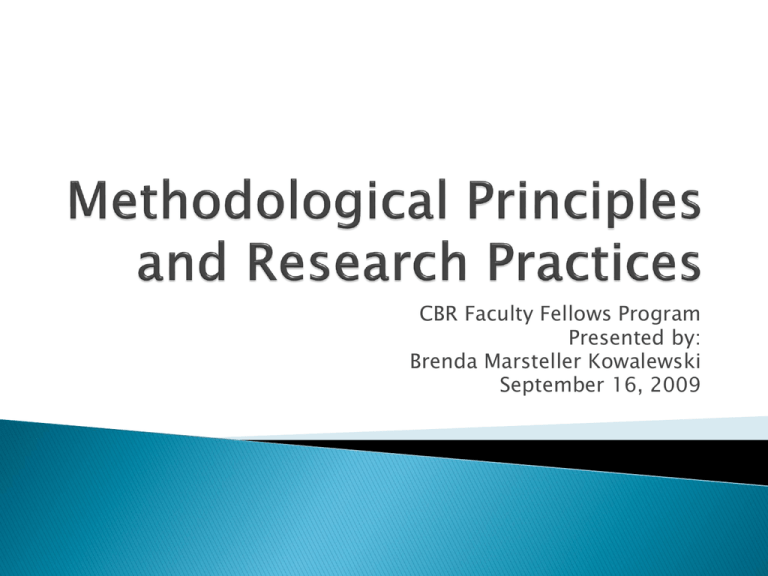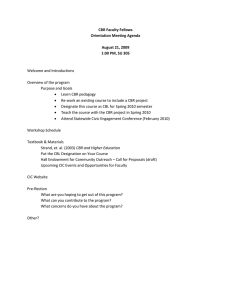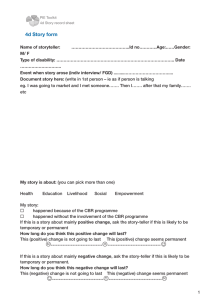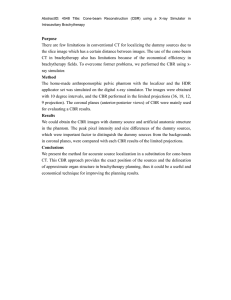CBR Faculty Fellows Program Presented by: Brenda Marsteller Kowalewski September 16, 2009
advertisement

CBR Faculty Fellows Program Presented by: Brenda Marsteller Kowalewski September 16, 2009 Outline the ideal principles of CBR and discuss how they translate to a real CBR project. Collaboration Democratization of knowledge Social Justice Outline the steps in CBR practices and identify any special considerations necessary in a CBR project as opposed to traditional research. Community is involved in each stage and phase of the CBR project Identifying the research question Choosing a research design and method Collecting the data Analyzing the data Reporting the results Full collaboration is not often achieved ◦ Working with grassroots orgs – often unorganized ◦ Working with one step up from grassroots CBR in the middle Agencies are more organized, leadership established but puts more distance between researcher and the organization’s clients Bare minimum for collaboration ◦ Defining research focus and question ◦ How and if the results will be used Family Self Sufficiency Program – Ogden Housing Authority ◦ Handout – book chapter CBR makes professors, students and community members all knowledge producers Use mixed research methods – quote p. 78 CBR insists on connectedness and relationship building; distance increases inaccuracy Researchers often struggle because of our training in traditional research and within our disciplines ◦ CBR challenges traditional conceptions of expertise and objectivity ◦ CBR neither recognizes nor respects rigid disciplinary boundaries – real problems don’t fit neatly into any one discipline CBR seeks to “contribute to altering some aspects of the political, social, or economic institutional operations or cultural context that give rise to a problem” – p. 81 Challenge the status quo Change is often times small ◦ Whereas research may be the focus of the researcher, it is only one small part of a bigger project for the community. ◦ Creating or affecting social change is difficult and knowledge is only one of the resources necessary to create any change Researchers have a hard time translating their findings into action. ◦ Youth Impact example Roles of the Researcher in Social Change (p. 84) ◦ Initiator – manages the social change project as well as the research ◦ *Consultant – manages the research only, and from a distance ◦ Collaborator – Is a full participant in social change project, but primarily as researcher or educator *Most researchers Step One – Choosing a problem Step Two – Identifying resources and solutions Step Three – Developing a plan Step Four – Implementing the plan Step Five – Evaluating ◦ Specifying what the range of problems might be or extent of a problem; example Youth Impact research ◦ Research on what resources already exist or researching solutions or models ◦ Introspective research where a group analyzes itself ◦ Research as action – Freedom Riders example, p. 92 ◦ Research done by the powerless on the powerful; participatory evaluation; example p. 93 Steps in CBR Project ◦ ◦ ◦ ◦ ◦ Identify the research question Choose a research design and method Collect the data Analyze the data Report the results There are special considerations that need to be made at each step in a CBR project Connect with a community organization needing research Find out what they want to know Translate what they want to know into a manageable research question Write the research question(s) down and post Traditional Research & CBR ◦ Resources (time, money, people) available ◦ Population characteristics ◦ Population availability ◦ Orientation and skills of the researcher ◦ The nature of the research question Additional criteria for CBR ◦ Purpose of the research ◦ Skill levels of students and community members ◦ Academic time crunch ◦ Learning goals Do you involve community members in data collection? ◦ Benefits Rewarding for community members Can act as “informants” Can build community relationships Community members develop expertise or skills ◦ Challenges Community members may be willing but are untrained Risk that data collection will not get done on time or done well enough From sources other than humans ◦ Archives and agency data, public records, newspapers, web sites, organizational charts, land use records, transcripts (YI example), etc. ◦ Challenges – incomplete or incomprehensible records, bureaucratic regulations that limit access, uncooperative or incompetent gatekeepers, bad weather, etc. From human subjects ◦ More challenging than gathering samples from other sources ◦ Securing participants ◦ Sample size and representativeness take a back seat ◦ Ethical issues – protecting the privacy and dignity of respondents IRB Application Form http://www.weber.edu/IRB/application_form.html Training for students http://cme.cancer.gov/clinicaltrials/learning/humanparticipant -protections.asp Ideally, faculty, students and community partners are involved ◦ Academic researchers bring experience, training and access resources ◦ Students carry out the data entry and analysis ◦ Community partners provide an insider’s view on findings and their uses Most CBR analysis can be done with basic training and resources Key Questions: ◦ In what format should results be presented? ◦ Where should results be shared? ◦ Who should present the findings? Written Reports PowerPoint presentation Skit Colorful Poster illustrating key results in graphs Press release Press conference Theatrical presentation Demonstration or rally Campus-based presentations ◦ Sharing results with community partners ◦ Service Symposium Community-based presentations Academic Conferences If the social change requires the action of an external party, the researcher may be the most appropriate person to present. If the students have been the most intimately involved with the CBR project or if the project involves some politically charged issue, the students may be the most appropriate. If the research is primarily for the community, it may be best received if community members present the findings.


